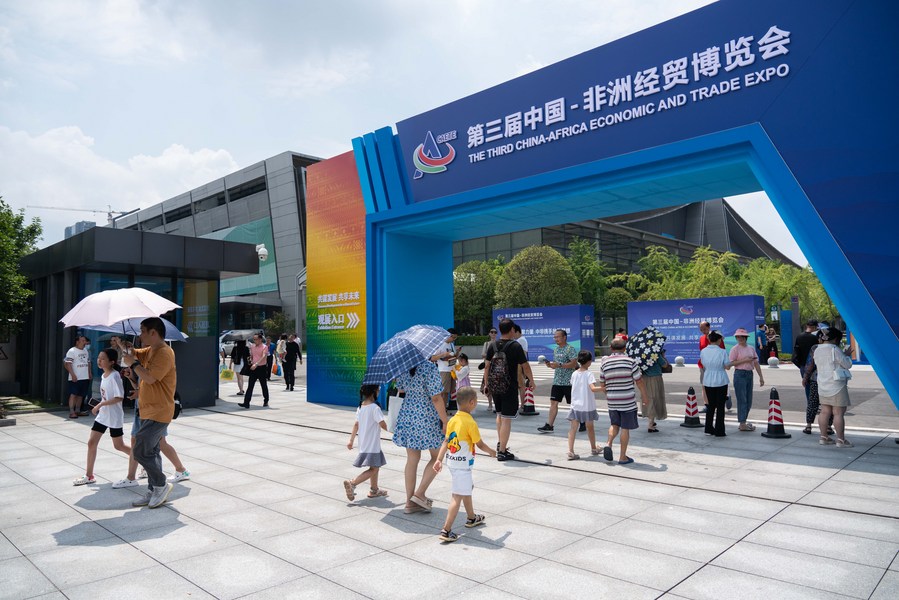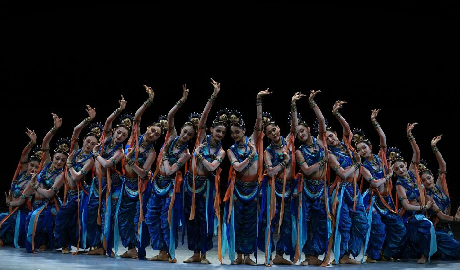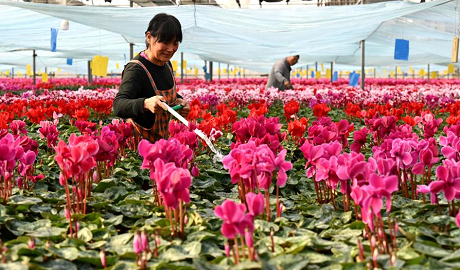


People visit a China-Africa achievement exhibition during the third China-Africa Economic and Trade Expo at the Changsha International Convention and Exhibition Center, central China's Hunan Province, June 29, 2023. (Xinhua/Chen Yehua)
Building a community with a shared future for mankind requires the concerted efforts of like-minded people worldwide, underpinned by comprehensive strategies aimed at sustainable development and social, economic, and environmental justice. This vision must rest on the fundamental principles that shape a harmonious global community distinct from the oppressive, exploitative world order entrenched during the unipolar era following the fall of the Berlin Wall.
China was quick to grasp that its fate is intertwined with that of the Global South, including Africa, recognizing that all nations now inhabit a highly interconnected world – one that has transformed into a global village with advances in communication and transportation, where intellectual, cultural, and civilizational exchange is inevitable. Therefore, it’s important that all of us, except for extremists and perpetrators of heinous crimes, seek new, viable models for peaceful coexistence and productive cooperation across civilizations and cultures to foster global peace, stability, and prosperity.
A successful development model
The unipolar world order that emerged after the Cold War failed to deliver lasting global peace. As countries in the Global South, particularly in Latin America, Africa, and Asia, began to call for a new multipolar system, China stepped forward with initiatives aimed to provide strategic direction for shaping a new world order that is aligned with changing global realities. Built on the principles of mutual respect and cooperation, these efforts introduced innovative approaches to global peace that benefit and mobilize all in creating a better, conflict-free world.
During the recent 19th G20 Summit, President Xi Jinping reiterated China’s unwavering commitment to the Global South, pledging to stand alongside developing nations on the path to modernization. What reinforces African nations’ trust in China is the clear contrast between China’s partnership approach and the exploitative engagement historically adopted by the West. Whereas relations with the colonial West were often marked by political and economic dominance, China’s cooperation emphasizes mutual benefit and shared prosperity.
The concept of “Chinese modernization” describes China’s distinctive approach to achieving economic and social progress. Representing a unique path to growth, this model stands out from other successful models in the world, particularly those in East Asia.
A defining feature of the Chinese model is long-term centralized planning. Through initiatives like its “Five-Year Plans,” the government outlines strategic economic and social goals, allocating resources accordingly. The model blends market-driven growth with substantial state intervention. While China encourages the private sector to flourish, the state retains regulatory influence over key sectors by owning major enterprises and overseeing strategic industries.
China places considerable emphasis on infrastructure development – including roads, bridges, ports, and railways – which it views as critical for driving economic growth and promoting regional development. Simultaneously, it prioritizes technological innovation by investing heavily in research and development, focusing on cutting-edge fields such as artificial intelligence, telecommunications, and biotechnology.
Over the years, China has also introduced a range of reforms to optimize the business environment and enhance market efficiency, including trade liberalization, stronger property rights protections, and simplified administrative processes. Additionally, it has implemented policies aimed at narrowing regional disparities, providing targeted financial and developmental support to less developed areas.
The Chinese model places great importance on social and political stability as a prerequisite for sustainable development. The government emphasizes maintaining political and social order to ensure continued growth. This model uniquely combines elements of socialism and capitalism: a thriving private sector coexists with significant state-driven key industries, ensuring strategic oversight. In recent years, China has increasingly focused on sustainable development, investing in renewable energy, environmental protection, and pollution control.
Inspiration through partnership
China’s development model offers a compelling source of inspiration for African nations seeking to accelerate their modernization drives. Given its proven success and broad global recognition, the model resonates with African and other countries in the Global South, as it aligns with their shared values and aspirations. To fully harness the benefits of this model, however, African countries must establish genuine partnerships with China. Meaningful progress cannot be achieved remotely – it requires China’s direct involvement through investments and expertise. Such partnerships would enable Africa to unlock its potential, leveraging its abundant natural resources, strategic location, and vast consumer market while providing China with valuable opportunities for investment.
African countries stand to benefit from China’s economic and technical support in fields such as agriculture, renewable energy, industry, technology, education, and cultural exchange. Additionally, Chinese investments in infrastructure – such as roads, railways, airports, and power plants – are vital for improving living standards across the continent.
There is also significant potential for collaboration in technological innovation. Africa can benefit from China’s experience in cutting-edge fields like artificial intelligence, robotics, renewable energy, and nuclear technology, fostering technological advancement and enhancing quality of life. Knowledge-sharing initiatives, including joint research and development programs in renewable energy, agriculture, and smart manufacturing, could further strengthen Africa’s progress.
Direct investments in Africa’s innovation-driven sectors can enhance competitiveness and bolster industrial and technological growth. Moreover, African countries seek to expand educational opportunities through scholarships and training programs in science and technology, which would help build a skilled workforce equipped to meet future challenges.
Another avenue for partnership lies in academic and research collaborations between universities and research institutions. Such initiatives could promote technology exchange and joint projects in various fields. Africa also hopes to leverage China’s support in developing its digital infrastructure – such as communication networks and high-speed internet – to boost access to information and enable greater innovation.
Furthermore, African nations aim to benefit more extensively from China’s Belt and Road Initiative (BRI). This ambitious initiative has already facilitated the development of critical infrastructure – ports, railways, energy facilities, and communication networks – which can play a crucial role in accelerating Africa’s modernization. Since its launch, the BRI has caught the attention of the world, with substantial investments channeled into key projects. By participating more actively in these programs, African countries can better position themselves to adopt elements of China’s modernization model.
In summary, China’s inspiring modernization experience offers a valuable blueprint for African development, but its impacts will be maximized only through deeper, on-the-ground engagement. By becoming a proactive partner in Africa’s transformation, China can help build a community of shared future for mankind, one that is rooted in mutual respect, understanding, and collaboration across cultures.
Contributed by Majed Barhoumi, Head of the Maghreb Center for Research, Studies, and Documentation, Tunisia

Artists of China National Opera House perform in dance drama "Qiuci" in Beijing


Fishermen dry seafood to supply market in Tangshan City, N China

In pics: flower plants of various kinds bloom at flower base in Hebei

Rongshui County strengthens ethnic culture with cultural resources in S China's Guangxi
点击右上角![]() 微信好友
微信好友
 朋友圈
朋友圈

请使用浏览器分享功能进行分享
